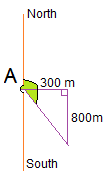
Introduction to bearings

True Bearings
In surveying and air navigation a true bearing measures the angle that a path or line makes with a fixed north-south line. A true bearing measures clockwise from North ALWAYS. For example in a true bearing we would measure this obtuse angle and say it has a bearing of $\theta$θ$^\circ$°T.

We also write true bearings using exactly three digits. So if $\theta$θ is less than $100$100 degrees, then the true bearing will look something like $040$040$^\circ$°T or $008$008$^\circ$°T.
Compass Bearings
The four main directions of a compass are known as cardinal points. They are north (N), east (E), south (S) and west (W).

A compass bearing is measured using the acute angle from the north south line.
 we would write the bearing of B from A as S$\theta$θ$^\circ$°E.
we would write the bearing of B from A as S$\theta$θ$^\circ$°E.
Which one first?
The bearing needed or used completely depends on which position comes first. Have a look at the investigation below, it quickly shows you how the angle changes depending on if we are measuring the bearing of A from B or B from A.
Example

A slightly lost hiker walks $300$300 m east before turning south and walking another $800$800 m. What is its true bearing from their original position (to $1$1 decimal place)? And then what is this as a compass bearing?
Think: to do this questions a diagram is a great way to start. This is the diagram I drew.

The angle we want to find is in green. It is equal to $90$90$^\circ$°$+$+the angle inside the triangle, which we can find using trigonometry.
Do: Bearing is
| $90+\tan^{-1}\frac{800}{300}$90+tan−1800300 | $=$= | $90+\tan^{-1}\frac{8}{3}$90+tan−183 |
| $=$= | $90+69.44$90+69.44 | |
| $=$= | $159.44$159.44 |
and to one decimal place the final bearing is $159.4$159.4$^\circ$°T.
As a compass bearing we need to know the acute angle with the North South line. This is $180-159.4=20.6$180−159.4=20.6
The compass points we will use will be South first, and then East, so the compass bearing is S$20.6$20.6$^\circ$°E.
Practice questions
Question 1
Consider the point $A$A.

Find the true bearing of $A$A from $O$O.
What is the compass bearing of point $A$A from $O$O?
$\editable{}$ $\editable{}$$^\circ$° $\editable{}$
Question 2
What is the true bearing of Southwest?
Question 3
The position of a ship S is given to be $20$20 kilometres from P, on a true bearing of $0$0$49$49$^\circ$°T.
The position of the ship can also be given by its $\left(x,y\right)$(x,y) coordinates.

If the ship's $x$x-coordinate is $x$x, find $x$x to one decimal place.
If the ship's y-coordinate is $y$y, find $y$y to one decimal place.
Question 4
In the figure below, point $B$B is due East of point $A$A. We want to find the position of point $A$A relative to point $C$C.

Find the true bearing of point $A$A from point $C$C.
What is the compass bearing of point $A$A from point $C$C?
$\editable{}$ $\editable{}$$^\circ$° $\editable{}$